Biography
Having always been fascinated by nature and the environment, I studied Biology at University College London. Through my studies I became aware that biology and ecology can play a vital role in safeguarding harvests from attack by pests. My undergraduate project was on insect pests of rice and their natural enemies in Malaysia. I completed an M.Sc. in Applied Entomology at Silwood Park, Imperial College London and a Ph.D. in Chemical Ecology at the Natural Resources Institute, University of Greenwich. My PhD thesis was on the role of olfaction in host location by the cotton bollworm, Helicoverpa armigera, with lab studies in the UK and field studies in Israel and Pakistan.
Agriculture interests me because of the vital role it plays in global food security and the opportunities for reducing our environmental footprint through more efficient farming practices. I joined Rothamsted Research, an organisation that pioneered using science to benefit agriculture, as a Research Scientist in 2000. My role was to study agriculturally important insects, their interactions with their host plants and their natural enemies; seeking novel interventions that could improve pest management and reduce dependency on pesticides. For example, I helped to develop improved management of orange wheat blossom midge, Sitodiplosis mosellana, based on resistant wheat varieties and pheromone traps to rationalise insecticide use and evaluated transgenic wheat engineered to release the aphid alarm pheromone. We have had a very successful collaboration with scientists at icipe in Kenya.
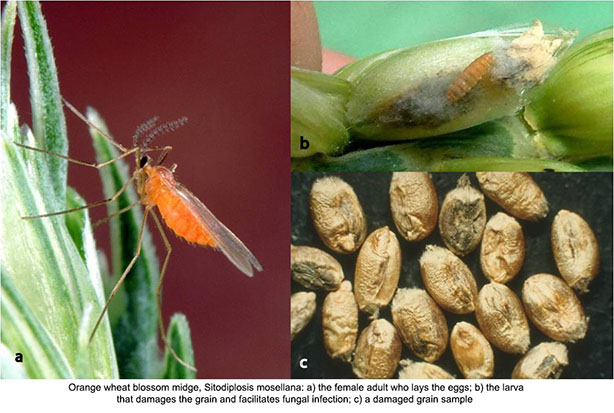
I obtained a scientific merit promotion to Senior Research Scientist at Rothamsted in 2007. I gained university teaching experience from guest lectures at several UK and European universities and enjoy teaching. I successfully supervised PhD students in outstanding and highly cited research. In 2012, I became Convenor of the Association of Applied Biologists Biocontrol and IPM group, a visiting Professor at the University of Greenwich and a visiting Lecturer at the University of Nottingham. In 2016, I became editor-in-chief of the journal Physiological Entomology and co-editor of Annals of Applied Biology.
In 2017, I was recruited by Keele University to build a new group within our expanding and thriving School of Life Sciences. I am very excited about this new opportunity to strengthen hypothesis driven research, geared towards improving food security by reducing crop losses to pests. I hope to inspire the next generation of researchers to tackle global challenges and push back the boundaries of science.
Research and scholarship
The Bruce group at Keele is conducting cutting-edge research on insect-host interactions and testing hypotheses to better understand how to sustainably manage pest species and conserve beneficial species. Our group is advancing science on major global pests of agriculture. The species we work with are notorious for their ability to evolve insecticide resistance and new sustainable but effective options for their management are urgently needed.
Research Projects
We currently have four main research projects:
- Enhancing crop diversity and ecosystem services to promote biological control of fall armyworm in smallholder cropping systems (BB/R020795/1)
- Chemical study of insect-plant interactions: a contribution to biorational control of crop pests (BB/R022755/1)
- Biological crop protection: a new 'slow down/speed up' strategy for aphid management (BB/R021708/1)
- Hijacking plant immunity: winners and losers in dual pest and pathogen attacks on a shared host
1. Enhancing crop diversity and ecosystem services to promote biological control of fall armyworm in smallholder cropping systems (collaboration with icipe in Kenya)

Fall armyworm (FAW), Spodoptera frugiperda, biology and behaviour on different farmer-preferred crop varieties is being measured in bioassays to assess constitutive and induced resistance. Smallholder farmers in much of Africa practice mixed cropping. Thus, a Push-Pull system is being developed modelled along the polycropping nature of local farming systems, for which repellent intercrop (Push) and attractive trap crop (Pull) components are required. Candidate repellent intercrops are being tested for their ability to repel FAW moths, and include a range of African food legumes; while candidate attractive trap crops are being tested for their ability to attract the moths. Field sampling is being conducted to determine the key natural enemies that attack FAW and insects reared in the laboratory so that parasitoids emerging can be recorded. Field sampling of potential reservoir hosts (wild plants) is being conducted to determine their role in pest epidemiology and the possible ecosystem service they may provide by acting as habitat for natural enemies of the pest. To assess indirect defence, volatiles collected from infested plants are being tested in an olfactometer to determine if key predators and parasitoids prefer them. Volatiles from intercrops are being tested for attraction of natural enemies. For plants that have reduced feeding and growth rates of FAW larvae, secondary metabolites are being extracted by solvent washing and the collected extracts analysed by HPLC. Volatiles are being collected from plants that significantly repel or attract insects, or where a difference in moth oviposition preference is observed. Headspace samples of volatiles are being analysed by GC-EAG and GC-MS to identify bioactive compounds. Field trials are being conducted with crops with improved resistance to FAW grown with appropriate companion crops to support biological control by natural enemies. Co-design workshops are being held with participating farmers and trials are being held on their farms. The main postdoc researcher for this project at Keele is Dr Islam Sobhy.
2. Chemical study of insect-plant interactions: a contribution to biorational control of crop pests (collaboration with UFSCar and UNESP in Brazil)
New solutions for managing insect pests are urgently needed due to evolution of resistance to current insecticides. This project focuses on development and bioactivity testing of novel nanotech formulations of plant secondary metabolites that could provide new options for crop protection. The Federal University of São Carlos (UFSCar) group has strong preliminary data showing that nanotech formulations of certain plant flavonoids complexed with Mg (II) substantially reduce growth of insects. Preliminary experiments done by the Keele University (KU) group with PAA (poly(allylamine)) nanotech formulations of essential oils have shown highly significant repellent action, with greatly enhanced activity compared to conventionally formulated material. UK-Brazil collaboration would provide an ideal opportunity to strengthen this new and promising area of research. The project includes Workshops and exchange visits to build a research network between the groups. Both groups are sharing expertise and work together to create novel nanotech formulations of plant secondary metabolites (flavonoids such as Hesperidin and Naringenin, phenolic acids and essential oils). Parallel experiments are being conducted testing activity against selected insects, chosen due to their relevance to Brazilian agriculture and insecticide resistance challenges. Bioassays with Western flower thrips, Frankliniella occidentalis, and peach-potato aphid, Myzus persicae, are being conducted at KU; with whitefly, Bemisia tabaci, at São Paulo State University (UNESP), and with fall armyworm, Spodoptera frugiperda at UFSCar. Antibiotic, antifeedant and repellent activity are being tested for using established methods. The experiments conducted in the pump-priming project are revealing the potential for use of nanotechnology to improve the formulation of plant secondary metabolites for use against insects. The project is benefiting from the expertise in the KU School of Pharmacy Co-I who has considerable expertise inevelopment of nanotech formulations for the medical sector. We are evaluating the extent to which low cost technologies already developed for medicines can be translated into the agricultural field. In addition to the programme of empirical research, we are conducting a literature review of the area and submit this to a high quality scientific journal as a contribution to knowledge. We think there is considerable potential for cross-fertilisation between the disciplines involved in the project (chemistry, medicine and entomology). This has potential to allow agricultural formulation technology to "leapfrog" into nanotechnology by using approaches already developed for Medicine. Furthermore, there are, of course, be insights gained by sharing insights with the Brazilian scientists who are at the forefront of the development of nanotechnology for crop protection. The project has considerable potential to generate much needed new tools for managing insect pests of crops. The main postdoc researcher for this project at Keele is Dr David Buss.
3. Biological crop protection: a new 'slow down/speed up' strategy for aphid management (collaboration with University of Warwick)
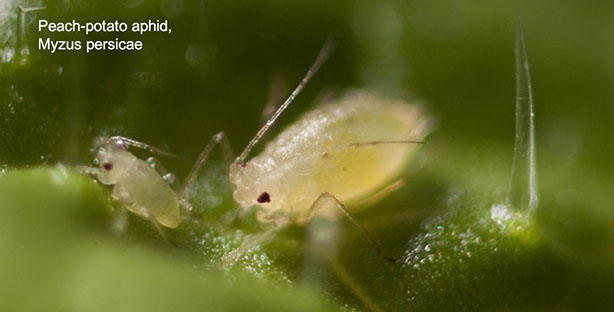
This project will underpin the development of a 'slow down / speed up' IPM system for aphid pests of field crops that combines plant breeding and biological control, focusing on the peach potato aphid, Myzus persicae. Our approach involves slowing down the growth rate of pests while speeding up the performance of their natural enemies. We are investigating the hypothesis that brassica genotypes with partial resistance that slows down aphid development makes the pest more susceptible to biological control agents including biopesticides and parasitoids. Studies have shown that defence responses in Arabidopsis against M. persicae are based around phytohormone signalling pathways and the phytoalexin camalexin. Expression analysis of gene homologues in Brassica accessions indicates that identifying partial resistance to M. persicae in Brassica crop breeding material is highly likely. The project explores how this partial host-plant resistance can be combined with biocontrol agents. The research has 5 components: (1) Candidate Brassica genotypes with potential resistance are be evaluated using a combination of transciptome analysis and phenotyping experiments. (2) The molecular basis for partial resistance to M. persicae are being investigated, informed by experiments that quantify aphid feeding and development on Brassica genotype breeding lines with aphid resistance markers. (3) Fungal biopesticides are being evaluated against M. persicae on resistant brassica genotypes and research are being done to quantify how biopesticide performance is affected by the fluctuating environmental conditions occurring in field crops. (4) The responses of parasitoids to volatiles from aphid-infested Brassica genotypes are being quantified and the role of cis-jasmone in parasitoid attraction is being elucidated. (5) Field experiments are then being done to measure aphid control on different Brassica genotypes following treatment with fungal biopesticides, parasitoids and cis-jasmone. The main postdoc researcher for this project at Keele is Dr Joe Roberts.
4. Hijacking plant immunity: winners and losers in dual pest and pathogen attacks on a shared host (collaboration with University of Nottingham)
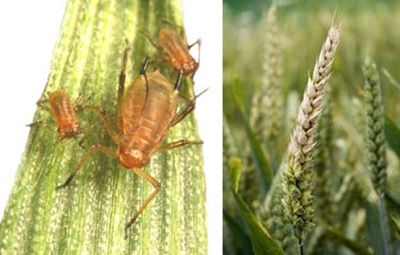
Plants cannot run away when an attacker comes to attack them. Being unable to flee means that they are under pressure to resist attackers... they do this by switching on defences such as the production of antibiotic plant chemicals. Meanwhile, the attackers have adapted to supress plant defence responses to colonise their host. An interesting and important question is, "what happens when plants are exposed to more than one attacker?" Here we consider the case of wheat, a globally important crop for global food security, and two of its key attackers: aphids (greenfly) and Fusarium head blight (FHB) disease. FHB is a major disease of wheat caused by Fusarium graminearium, an aggressive fungal pathogen. The disease also produces toxins (called mycotoxins), deoxynivalenol (DON) and nivalenol (NIV), in the grain, which are harmful to humans and animals when consumed. Most previous studies of plant diseases and pests have considered them in isolation and little is known of the interactions between them. Aphids occur in cereal fields at the same time as FHB and interact with the disease and the wheat host plant. Our early findings show that FHB disease infection is doubled on plants with aphids when compared to clean plants. Here we will determine how and why this happens. We will investigate the biochemical and molecular basis of this aphid-induced plant defence suppression. We will conduct gene expression analyses of the wheat host and the aphid and will analyse differences in biochemical production. We will define and characterise the modulated host-defence networks in our biological experiments and determine their biological significance. Insects are influenced by the odours that plants release: a diseased plant smells different from a healthy one and may become repellent. We will collect plant odours, identify their chemical structures and expose aphids to them to test how they respond. We will make electrical recordings from insect antennae to determine which chemicals they can smell and do behaviour tests to see if they are attracted or repelled. Finally, the project will carry out experiments to determine if the aphids are able to metabolise the toxins produced by the FHB disease. The results from changes in the gene expression and metabolism of the aphid exposed to the mycotoxins will identify new detoxification pathways in the insect relevant to future targets for insect control. Our project will allow us to define novel molecular and metabolomic targets for making our crops more resilient to the aphid pest and the pathogen causing FHB disease in wheat. The main postdoc researcher for this project at Keele is Dr Amma Simon
Earlier Research
You can hear about my research in my inaugural lecture here:
https://youtu.be/6AjoSOugkzk
My scientific achievements include improving understanding of how insects use olfaction to recognise their host plants (Bruce, Wadhams & Woodcock, 2005; Bruce & Pickett 2011). I showed that host odour coding is usually via blends of widely occurring plant volatiles rather than compounds specific to their host and suggested a ‘coincidence detection’ hypothesis in which insects have very high spatio-temporal resolution of olfactory cues and use space and time to put the cues in context. An extreme example of this blend odour coding was when black bean aphid, Aphis fabae, was shown to be repelled by host plant volatiles when they were presented to it individually but repelled when they were presented as a blend (Webster et al 2010).

Understanding how plants react to biotic stress such as insect attack. In 2007, I hypothesised that epigenetic mechanisms could explain long-lived plant defence priming phenomena in which a plant can respond more quickly and strongly to subsequent exposure when exposed to a previous stress than a naïve plant (Bruce et al. 2007). This type of plant ‘stress memory’ seemed controversial at the time but in the last decade more evidence to support it has accumulated. My collaborative research with scientists in Kenya has advanced understanding of how maize plants respond to insect egg laying to release volatiles that attract natural enemies of the herbivore. We initially found that certain farmer preferred landraces of maize respond to stemborer insect egg laying: these maize varieties produce different odours, after insect egg laying (Tamiru et al., 2011). The changes in smell repel the pest herbivore (stemborer moths) and attract natural enemies of this devastating pest. The natural enemies (parasitic wasps) use the smells to locate plants colonised by pest and then parasitise their eggs and larvae (immature caterpillars), thus preventing the crops from being damaged. In a larger project, which I obtained funding for, we found this trait also exists in improved maize varieties although it is much rarer than in landraces (Tamiru, Khan and Bruce, 2015).
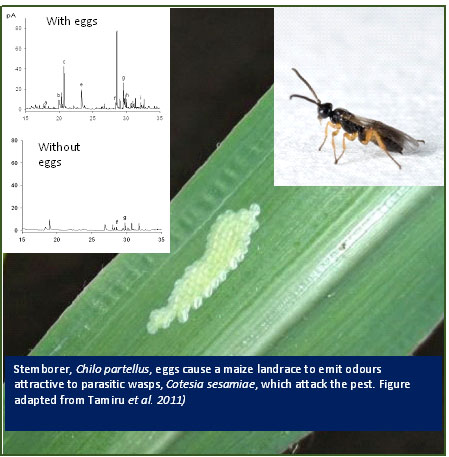
I have been involved in numerous studies with a common theme of biological interactions. Recent developments have included showing that grain aphids can facilitate Fusarium head blight disease in wheat (Drakulic et al. 2017) and that virus infection of tomato plants can make them more attractive to buzz-pollinators (Groen et al. 2016). I have an excellent publication record with over 100 papers in peer-reviewed Journals, including PNAS, Ecology Letters, Nature Climate Change and Trends in Plant Science. I have been invited as a keynote speaker to numerous scientific meetings, for example, the Plant Volatiles Gordon Conference in 2016. I have developed and mentored talent especially in PhD students and postdoc fellows, several of whom have achieved highly cited publications. I am keen on outreach and developed a smartphone App for farmers to report crop protection targets and obtain management recommendations for pests, weeds and diseases.
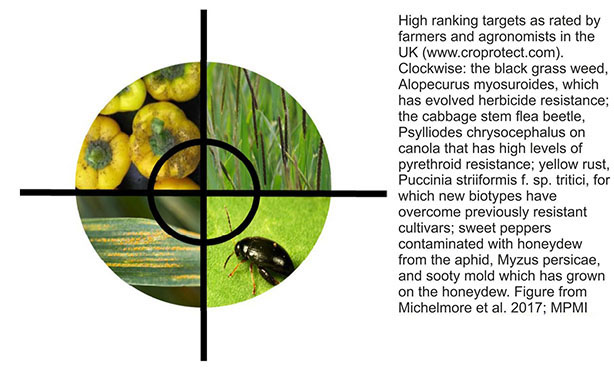
Bruce, Toby JA, and John A. Pickett. (2011) Perception of plant volatile blends by herbivorous insects–finding the right mix. Phytochemistry 72: 1605-1611.
Bruce, Toby JA, et al. (2007) Stressful “memories” of plants: evidence and possible mechanisms. Plant Science 173: 603-608.
Bruce, Toby JA, Lester J. Wadhams, and Christine M. Woodcock (2005) Insect host location: a volatile situation. Trends in plant science 10: 269-274.
Drakulic, J., T. J. A. Bruce, and R. V. Ray. (2017) Direct and host‐mediated interactions between Fusarium pathogens and herbivorous arthropods in cereals Plant Pathology 66.1: 3-13.
Groen, Simon C., et al. (2016) Virus infection of plants alters pollinator preference: A payback for susceptible hosts? PLoS Pathog 12: e1005790.
Michelmore et al. (2017) Foundational and Translational Research Opportunities to Improve Plant Health. MPMI 30: 515 https://doi.org/10.1094/MPMI-01-17-0010-CR
Tamiru, Amanuel, et al. (2011) Maize landraces recruit egg and larval parasitoids in response to egg deposition by a herbivore. Ecology Letters 14: 1075-1083.
Tamiru, Amanuel, Zeyaur R. Khan, and Toby JA Bruce. "New directions for improving crop resistance to insects by breeding for egg induced defence." Current Opinion in Insect Science 9 (2015): 51-55.
Webster, Ben et al. (2010) Volatiles functioning as host cues in a blend become nonhost cues when presented alone to the black bean aphid Animal Behaviour 79: 451-457.
Teaching
I am responsible for lecturing on nine modules and am currently supervising five student projects. I am a member of the Life Sciences Teaching Team and Research Committee. Prospective PhD students, please email me your CV and details of any funding you may have found.
- PhD supervisor – currently one student: Jamin Ali
- PhD viva examiner (done 5 in the last year)
- Project supervisor for LSC 30045 Double experimental and LSC 30048 Single experimental:
I am Module Manager for LSC 20062 “Living Together” and lecture on the following courses:
- LSC 10053 Animal Behaviour
- LSC 10054 Plants
- LSC 10056 Chemistry for Bioscience
- LSC 20056 Research and Analytical Skills
- LSC 20062 Living Together
- LSC 20074 Current Topics in Biology
- LSC-30003 Applied Insect Ecology
- LSC-30036 Human Parasitology
- Salford MSc: Vector Biology and control
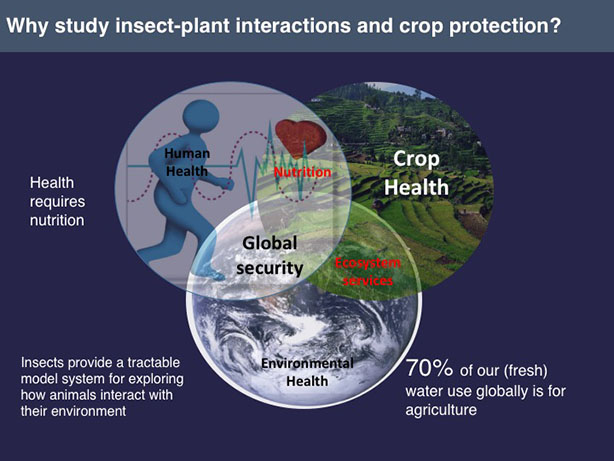
Students may like to know the purpose of my subject area: Ensuring crop health by better managing pests not only safeguards harvests but also reduces the environmental footprint of farming by allowing more efficient crop production. There is fascinating science in understanding the complex biological interactions between insects and other species.
Publications
My full publication list is available via Google Scholar: https://goo.gl/ZK6F0Z
School of Life Sciences,
Huxley Building,
Keele University,
Staffordshire,
ST5 5BG
Tel: +44 (0) 1782 734414
Enquiries:
Tel: +44 (0) 1782 734414
Email: lifesciences.office@keele.ac.uk


